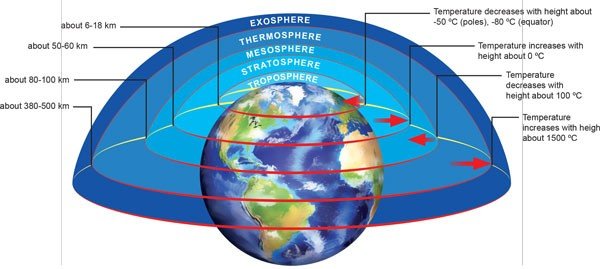Earth’s Atmosphere: Planet Earth is surrounded by a thick blanket of air, called the atmosphere. This atmosphere is composed of about 20 different gases, but oxygen and nitrogen account for about 90% in dry air. The atmosphere was formed when the hot surface of the Earth began to cool. As the molten rocky mass of the newly formed Earth cooled, the most volatile and lightest substances evaporated away as gases from the Earth’s interior. These gases formed the atmosphere. Sunlight and plants were mainly responsible for the changes in the composition of gases in the Earth’s atmosphere.
Exosphere: The Earth’s atmosphere is divided into five layers. The exosphere is the outermost layer of the Earth’s atmosphere. The upper part of this layer merges with space; hence it has no definite outer limit. This layer has almost no air/gases. It starts around 500 km above the sea level and extends outwards and interacts with the solar winds. Many man-made satellites orbit the Earth within this layer. The temperature range remains constant that is around 1227 °C and the altitude does not create any difference. Whenever solar storms occur, the exospheric layer is compressed due to excessive heat and pressure.
Thermosphere: The thermosphere is also called the ‘upper atmosphere’. This layer of the Earth’s atmosphere lies between the exosphere and the mesosphere. It starts at 80 km above the sea level, and extends up to 450 km above the sea level. The temperature in this layer increases with the increase in altitude. The thermosphere is a thin layer due to which it holds very little heat. The lower part of the thermosphere contains ionised molecules which reflect low frequency radio waves back to the Earth and is called the ionosphere.
Mesosphere: The mesosphere lies just above the stratosphere. It is the upper atmosphere region, which is located between 50 km and 80 km above the sea level. The mesosphere is the coldest layer of the atmosphere. The temperature decreases with the increase in altitude. The mesosphere is thicker than the exosphere and the thermosphere. The mesosphere and the stratosphere together are often called the ‘middle atmosphere’. Meteors that enter the Earth’s atmosphere, face friction in this layer. Due to this friction, these meteors end up burning themselves.
Ionosphere: It is an ion (small charged particles) rich layer that includes the lower part of the thermosphere and some part of the mesosphere. The ions in this layer affect the radio waves and are responsible for the creation of the electrical layer. This layer is very important for reflecting the radio waves and helping the communication satellites that orbit in space. The upper region of the ionosphere is called the magnetosphere as the charged particles present in this layer affect the magnetic field of the Earth. The ionosphere and the magnetosphere were discovered by a German mathematician Carl Friedrich Gauss in 1839.
Stratosphere: The stratosphere lies between the troposphere and the mesosphere. It is the second layer of the atmosphere as we go upward. The highest clouds are generally found in this layer. This layer of the atmosphere extends from the boundary of the troposphere at about 10-17 km to 50 km above the sea level. The atmosphere is more dry and dense in this layer. The lower portion of this layer has constant temperature, but as we travel further above in this layer, the temperature rises with respect to the altitude. The ozone layer lies in the upper region of the stratosphere. Jet planes fly in the stratosphere.
Solar Storm: This is an explosive event that takes place when the small particles on the surface of the sun collide and produce a huge flash of light.


